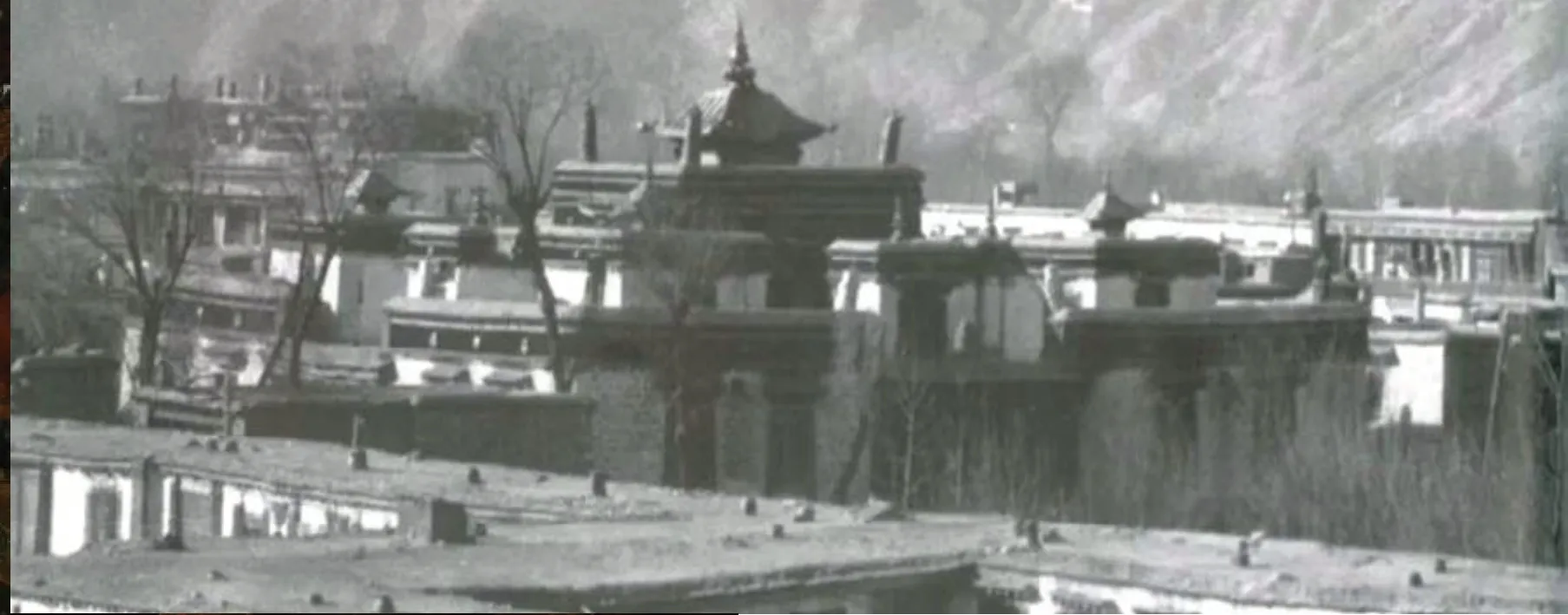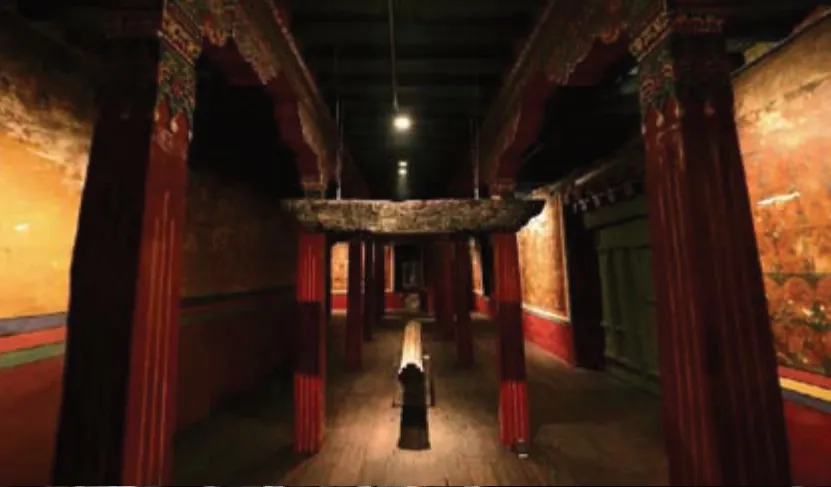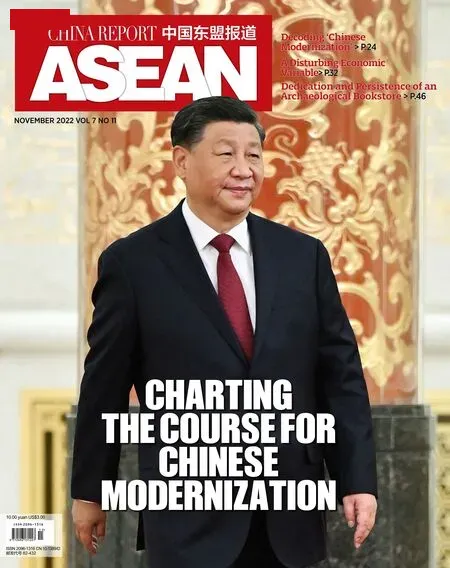Reviving Ancient Architecture
By Wang Yuanyuan
The ancient Jebumgang Lhakhang gains new vitality
Once upon a time,a clear and melodious bell could be heard ringing from Jebumgang Lhakhang through ancient Lhasa.Today,after completing its renovation,the ancient mandala-like compound Jebumgang in the capital of southwest China’s Tibet Autonomous Region has taken on a new look as a cultural and art center.

A mural in the Jebumgang Art Center.
The Past
Crisscrossed alleys paved with limestone slates and bustling open markets are what make the old town of Lhasa what it is.Following tourist maps hung across the Barkhor District,tourists can easily find a variety of old buildings and small temples.Jebumgang Lhakhang was one of them.
Located at the intersection of Ramoche Temple Road and Beijing East Road,the temple was adjacent to a fast-food restaurant and a wholesale market.Colors on the upper edge of the building had faded away over time.It was listed as a cultural relic in August 2010 during the third National Cultural Relics Census.
According to Dawa,author of A Study of Historical Place Names in the Ancient City of Lhasa,the place Jebumgang was named after the stupa built by the seventh Dalai Lama in the 18th century and enshrined with 100,000 statues of Master Tsongkhapa.The bottom floor of the fivestory stupa was a main hall,and people could overlook the ancient city from the top floor.
The stupa collapsed in the 19th century,and a new three-story temple was built later on the site to make offerings to a huge clay figure of the Buddha,with 100,000 Tsongkhapa statues around it.
During the 1970s,it served as the warehouse of a local grain bureau.After the launching of China’s reform and opening-up,it gradually became a trading market for zanba,or roasted highland barley flour.
Renovation and Protection
Today,Jebumgang Lhakhang has taken on a brand-new look.Since 2018,the local cultural and tourism department has invested funds and organized manpower to carry out comprehensive renovations to the ancient architecture.
The roofs and floors have been reinforced with traditional supports to prevent leaking;the columns that were in disrepair inside the buildings have been replaced;and the murals on the walls have been professionally cleaned.A variety of means were used to bring this ancient building back to life.
Later,the local government entrusted a Tibetan culture and art team to transform the ancient architecture into an art center.
The team extensively looked into domestic first-class cultural venues and cases on the protection and renovation of ancient buildings.It worked with a leading domestic architectural firm for the upgrading of Jebumgang Lhakhang.
Xia Yujun,executive architect responsible for the project,took the job because of his longstanding love for ancient architecture in Tibet and the entire Himalayan region.
The team carrying out the protection and renovation work overcame many difficulties.It took the team a lot of effort to just renovate the floor in order to “restore the old to make it look like the old.” The floor should not only maintain its original charm,but also support the power system of the contemporary art center.
After repeated discussions,the team worked out a plan for renovating the floor.A keel was erected on the original floor,leaving enough space for pipelines.By adjusting the height of each section of the keel,the finished surface of the wooden floor was kept basically level.This not only solved the problem of unevenness of the original floor,but also alleviates the needs of hiding various fixtures,such as a pipeline.
After the plan was finalized,Xia led the workers in measuring each inch of the floor,and customized the height of the keel to ensure overall evenness of the floor.In addition to this,the team searched for suitable old wooden floors across the country,transported them to Lhasa,and then had carpenters polish,cut and assemble them according to their texture,and finally laid them on the wooden keel.To this end,Xia and his team worked on the site for more than three months in a row,making the 580-squaremeter indoor space flat and uniform.

Jebumgang Lhakhang in the 1940s.

Inside the Jebumgang Art Center.

Architect Xia Yujun (right) works on upgrading Jebumgang Lhakhang.
Restoration of the floor was just one hurdle the team had overcome.The temple was located in a downtown area,surrounded by residential compounds and stores.If it was to become a public cultural space,facilities,such as video surveillance,running water,and fire protection equipment,must be installed properly.
To help people understand the renovation,Xia and his team visited the surrounding residents and peddlers and explained to them why the renovation should be done.
Xia turned the stories about these transformations into short videos and shared them online,attracting tens of thousands of viewers.
Good as New
The objective of all the dedicated hard work was to bring this place full of memories back to life.
Jebumgang Art Center,the first cultural and art space transformed from a protected ancient building in Tibet,was officially unveiled on July 25,2021.
The venue’s opening exhibition Growing Ancient City was also open to the public for free.In line with the venue’s architectural characteristics,the exhibition set three chapters in the outer corridor,inner hall,and main hall of the original building.
In the outer corridor,the curatorial team used extant murals from the Qing Dynasty (1644-1911) as the theme,and fleshed it out with a large number of information found in documents,and from experts and scholars,to offer a peek into the history of the ancient city and distinctive Tibetan culture.
The inner hall displayed a series of objects related to the ancient buildings,including wooden pillars and beams that once supported the inner hall,and stone carvings excavated during the restoration process.The exhibits helped viewers find out the ingenuity in the construction of ancient buildings and the reason behind the local government and enterprises’determination to invest a lot of manpower and material resources in repairing them.
Inside the original main hall,the exhibition used a beam of light to pay tribute to the creators of Tibetan classical architecture and traditional Tibetan culture.The curatorial team also placed two sets of audio equipment for playing Tibetan classical music,which created an apt environment for audiences to experience the charm of Tibetan classical architecture in an immersive manner.
The opening exhibition lasted till the end of September 2021.The exhibition in the outer corridor has been retained as a permanent exhibition.In the future,the art center will cooperate with top cultural and art institutions to launch public cultural education activities to spread traditional culture in contemporary languages and multiple forms.
From Jebumgang Lhakhang to Jebumgang Art Center,countless numbers of people have been dedicated to the revival of the ancient buildings.This ancient compound that was built according to a mandala structure is now showing new vitality,taking people on a journey to distinctive Tibetan culture.

